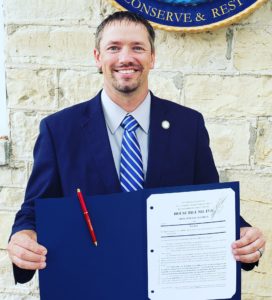
The Conservation Federation of Missouri's (CFM) mission is to ensure that the state’s wildlife, natural resources, and rich outdoor heritage are preserved through advocacy, education, and partnerships. They have over 100 affiliate organizations and more than 50 business partners throughout the state – together they are the voice for the Missouri outdoors. ESAL spoke with Colton Zirkle, education and communications coordinator at CFM, to find out about their work in the state.
RD: How did CFM come into existence?
Zirkle: Around the early 1930s, wildlife populations and habitats in Missouri were dwindling. Bears were a rare sight, and deer and turkey were hunted to near extirpation. On September 10th, 1935, a group of sportsmen gathered in the Tiger Hotel in Colombia to work out a solution to these issues. On that day, the Conservation Federation of Missouri was formed with the intention of creating a non-political state agency for science-based management of wildlife and their habitat. CFM was responsible for gathering the petition signatures and spreading the word of science-based natural resource management. The following year, the Missouri Conservation Commission and the Missouri Department of Conservation were created by Missouri voters through a ballot initiative constitutional amendment.
RD: Can you say a bit about your programs to get people started in conservation?

Colton Zirkle with legislation that helps enable distribution of venison and other foods.
Zirkle: CFM has several opportunities for young people to get involved in conservation at the state level. The Conservation Leadership Corps (CLC) is for high school upperclassmen and college students, and focuses on conservation policy. CLC shows students how they can make a difference and help direct management decisions for the state. Another program, the Missouri Collegiate Conservation Alliance, is offered to all college students free of charge throughout the state. This advocacy program teaches students how to engage with their elected officials and to share their perspective on conservation-related issues. CFM also runs a Young Professionals program that serves as a community for younger people involved in conservation throughout the state.
RD: Are there any programs you would like to highlight?
Zirkle: Missouri Stream Teams is a well-established program that has been highly successful – every county in the state has a team. Each one encompasses a group of people who get together to clean the litter out from streams in their area and to monitor water quality. Other programs such as Operation Game Thief and Operation Forest Arson serve as anonymous tip lines for people to report game violations or forest arson activity in their area.
RD: What are a few of your notable successes?
Zirkle: Share the Harvest is probably our most well-known program. Since its establishment in 1992, hunters have donated more than 4.3 million pounds of venison to their neighbors in need. This program is one of the greatest achievements of the Missouri Model of conservation. Out of the abundance of our wildlife resources, hunters can harvest and share their deer with food-insecure families in the state. The processing of the deer is paid for through a partnership with the Missouri Department of Conservation, Missouri Food Banks, and private donors within CFM. Afterward, Conservation Agents coordinate with local food banks to share with Missourians in need.
RD: What are the challenges faced by your programs?
Zirkle: A large percentage of our challenges stem from the state legislature. Every session, many bills are brought forward that potentially threaten conservation and science-based management of our natural resources. As a result, CFM created the Legislative Action Center (LAC) which serves as an advocacy network through which we notify and educate our constituents on issues affecting conservation at state and federal levels. When a concerning piece of legislation is proposed, we send out an actual alert to people who have subscribed to the LAC. Inside this alert is a link to act. Last year, more than 2,000 emails were sent to elected officials through the LAC.
RD: What sort of response have you seen to your programs?
Zirkle: The work of CFM is received very well! Our membership and affiliates are highly engaged in the work that we do, and we are very grateful – of course, we could not do it without them. Each one of them has their specific area of expertise and they serve as our resource when we go before committees in the Missouri Legislature and on a national level.
RD: What advice do you have for engineers and scientists who want to get involved?
Zirkle: I would invite them to become a member of the Conservation Federation of Missouri! And you can do that at our website and also look into our affiliate organizations who are listed there. I am sure there is something for everyone’ interests! Not all of our members are hunters and fishers. Some are cyclists or hikers, paddlers, or bird watchers – we span a large group of people who love the outdoors. I would invite them to join our Legislative Action Center, also available at the website, as it serves as our voice from the Missouri outdoors. You can learn more about and connect with the Conservation Federation of Missouri on Instagram, Facebook, Twitter, and YouTube.
Are you involved with an organization or effort that you think might be of interest to the ESAL community? Or have heard about an organization or initiative that you’d like to learn more about? Let us know here, and we may feature it in a future post.